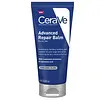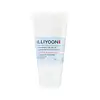What's inside
What's inside
 Key Ingredients
Key Ingredients

 Benefits
Benefits

 Concerns
Concerns

 Ingredients Side-by-side
Ingredients Side-by-side

Petrolatum
EmollientParaffinum Liquidum
EmollientCera Microcristallina
Emulsion StabilisingParaffin
PerfumingCaprylic/Capric Triglyceride
MaskingDimethicone
EmollientWater
Skin ConditioningCeramide NP
Skin ConditioningCeramide AP
Skin ConditioningCeramide EOP
Skin ConditioningCarbomer
Emulsion StabilisingTriethyl Citrate
MaskingSodium Lauroyl Lactylate
EmulsifyingSodium Hyaluronate
HumectantCholesterol
EmollientTocopheryl Acetate
AntioxidantTocopherol
AntioxidantCaprylyl Glycol
EmollientSynthetic Wax
AbrasivePanthenol
Skin ConditioningPhytosphingosine
Skin ConditioningXanthan Gum
EmulsifyingBenzoic Acid
MaskingPetrolatum, Paraffinum Liquidum, Cera Microcristallina, Paraffin, Caprylic/Capric Triglyceride, Dimethicone, Water, Ceramide NP, Ceramide AP, Ceramide EOP, Carbomer, Triethyl Citrate, Sodium Lauroyl Lactylate, Sodium Hyaluronate, Cholesterol, Tocopheryl Acetate, Tocopherol, Caprylyl Glycol, Synthetic Wax, Panthenol, Phytosphingosine, Xanthan Gum, Benzoic Acid
Water
Skin ConditioningButylene Glycol
HumectantGlycerin
HumectantEthylhexyl Stearate
EmollientDimethicone
EmollientDicaprylyl Carbonate
EmollientBehenyl Alcohol
EmollientStearic Acid
CleansingPalmitic Acid
EmollientCetyl Ethylhexanoate
EmollientHydrogenated Poly(C6-14 Olefin)
Emollient1,2-Hexanediol
Skin ConditioningArachidyl Alcohol
EmollientC14-22 Alcohols
Emulsion StabilisingCetyl-Pg Hydroxyethyl Palmitamide
Skin ConditioningPolyacrylate-13
Mannitol
HumectantArachidyl Glucoside
EmulsifyingC12-20 Alkyl Glucoside
EmulsifyingHydrogenated Polyisobutene
EmollientGlyceryl Caprylate
EmollientEthylhexylglycerin
Skin ConditioningPolyglyceryl-10 Laurate
Skin ConditioningHydrogenated Lecithin
EmulsifyingEthylhexyl Palmitate
EmollientDimethiconol
EmollientPanax Ginseng Root Water
MaskingCarbomer
Emulsion StabilisingSorbitan Isostearate
EmulsifyingAcrylates/Ammonium Methacrylate Copolymer
Scutellaria Baicalensis Root Extract
AstringentPropanediol
SolventCholesterol
EmollientSilica
AbrasivePrunus Mume Fruit Extract
HumectantArachidic Acid
CleansingGlycine Max Oil
EmollientSqualane
EmollientMadecassoside
AntioxidantPolyglyceryl-10 Pentastearate
Skin ConditioningTocopherol
AntioxidantCeramide NP
Skin ConditioningOleic Acid
EmollientPhytosphingosine
Skin ConditioningPentylene Glycol
Skin ConditioningDipotassium Glycyrrhizate
HumectantCanola Oil
EmollientRosmarinus Officinalis Leaf Extract
AntimicrobialWater, Butylene Glycol, Glycerin, Ethylhexyl Stearate, Dimethicone, Dicaprylyl Carbonate, Behenyl Alcohol, Stearic Acid, Palmitic Acid, Cetyl Ethylhexanoate, Hydrogenated Poly(C6-14 Olefin), 1,2-Hexanediol, Arachidyl Alcohol, C14-22 Alcohols, Cetyl-Pg Hydroxyethyl Palmitamide, Polyacrylate-13, Mannitol, Arachidyl Glucoside, C12-20 Alkyl Glucoside, Hydrogenated Polyisobutene, Glyceryl Caprylate, Ethylhexylglycerin, Polyglyceryl-10 Laurate, Hydrogenated Lecithin, Ethylhexyl Palmitate, Dimethiconol, Panax Ginseng Root Water, Carbomer, Sorbitan Isostearate, Acrylates/Ammonium Methacrylate Copolymer, Scutellaria Baicalensis Root Extract, Propanediol, Cholesterol, Silica, Prunus Mume Fruit Extract, Arachidic Acid, Glycine Max Oil, Squalane, Madecassoside, Polyglyceryl-10 Pentastearate, Tocopherol, Ceramide NP, Oleic Acid, Phytosphingosine, Pentylene Glycol, Dipotassium Glycyrrhizate, Canola Oil, Rosmarinus Officinalis Leaf Extract
 Reviews
Reviews

Ingredients Explained
These ingredients are found in both products.
Ingredients higher up in an ingredient list are typically present in a larger amount.
Carbomer is a polymer of acrylic acid. Its main role is to create a gel consistency.
A high amount of carbomer can cause pilling or balling up of products. Don't worry, most products contain 1% or less of carbomer.
Ceramide NP is a type of ceramide and formally known as ceramide 3.
Ceramides are intercellular lipids naturally found in our skin that bonds dead skin cells together to create a barrier. They are known for their ability to hold water and thus are a great ingredient for dry skin.
Ceramides are an important building block for our skin barrier. A stronger barrier helps the skin look more firm and hydrated. By bolstering the skin ceramides act as a barrier against irritating ingredients. This can help with inflammation as well.
If you would like to eat ceramides, sweet potatoes contain a small amount.
Read more about other common types of ceramides here:
Ceramide AP
Ceramide EOP
Cholesterol is a class of organic molecules called lipids. It helps hydrate your skin and is essential to having a healthy skin barrier.
Our skin naturally contains cholesterol in the outermost layer. Besides cholesterol, it also contains ceramides and fatty acids. Cholesterol makes up about 1/4 of your skin's outer layer and barrier. Your skin barrier is responsible for keeping allergens and microbes out. Having a healthy skin barrier is also responsible for keeping your skin firm and plump.
Our bodies use cholestrol to create vitamin D, steroid hormones, and more.
Learn more about CholesterolDimethicone is a type of synthetic silicone created from natural materials such as quartz.
What it does:
Dimethicone comes in different viscosities:
Depending on the viscosity, dimethicone has different properties.
Ingredients lists don't always show which type is used, so we recommend reaching out to the brand if you have questions about the viscosity.
This ingredient is unlikely to cause irritation because it does not get absorbed into skin. However, people with silicone allergies should be careful about using this ingredient.
Note: Dimethicone may contribute to pilling. This is because it is not oil or water soluble, so pilling may occur when layered with products. When mixed with heavy oils in a formula, the outcome is also quite greasy.
Learn more about DimethiconePhytosphingosine is a phospholipid naturally found in our skin as a building block for ceramides.. It helps moisturize, soothe, and protect skin.
Phytosphingosine contributes to your skin's natural moisturizing factor (NMF). The NMF is responsible for hydration, a strong barrier, and plasticity. Our NMF decreases with age. Increasing NMF leads to more healthy and hydrated skin.
Studies show products formulated with NMF ingredients help strengthen our skin's barrier. Having a healthy skin barrier reduces irritation and increases hydration. Our skin barrier is responsible for having plump and firm skin. It also helps protect our skin against infection, allergies, and inflammation.
Fun fact: Phytosphingosine is abundant in plants and fungi.
More ingredients that help boost collagen in skin:
Learn more about PhytosphingosineTocopherol (also known as Vitamin E) is a common antioxidant used to help protect the skin from free-radicals and strengthen the skin barrier. It's also fat soluble - this means our skin is great at absorbing it.
Vitamin E also helps keep your natural skin lipids healthy. Your lipid skin barrier naturally consists of lipids, ceramides, and fatty acids. Vitamin E offers extra protection for your skin’s lipid barrier, keeping your skin healthy and nourished.
Another benefit is a bit of UV protection. Vitamin E helps reduce the damage caused by UVB rays. (It should not replace your sunscreen). Combining it with Vitamin C can decrease sunburned cells and hyperpigmentation after UV exposure.
You might have noticed Vitamin E + C often paired together. This is because it is great at stabilizing Vitamin C. Using the two together helps increase the effectiveness of both ingredients.
There are often claims that Vitamin E can reduce/prevent scarring, but these claims haven't been confirmed by scientific research.
Learn more about TocopherolWater. It's the most common cosmetic ingredient of all. You'll usually see it at the top of ingredient lists, meaning that it makes up the largest part of the product.
So why is it so popular? Water most often acts as a solvent - this means that it helps dissolve other ingredients into the formulation.
You'll also recognize water as that liquid we all need to stay alive. If you see this, drink a glass of water. Stay hydrated!
Learn more about Water